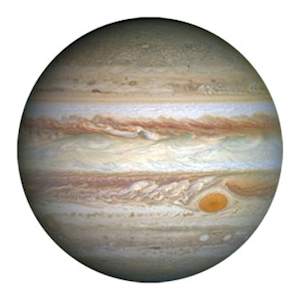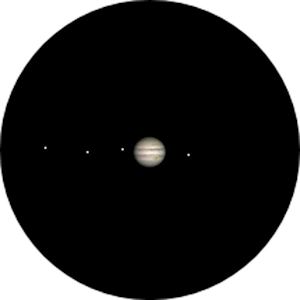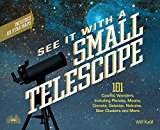1. Reset your expectations!
We are all spoiled a bit by the Hubble telescope. We expect to see things like this:

But with a small telescope you will see something like this:

While this view is not as dramatic as the Hubble view it still is truly remarkable. You are viewing Jupiter like no human being ever has throughout history, Until Galileo and his small telescope.
So, reset your expectations. Turn it into a treasure hunt. How many different things can you find with your small telescope! Here is a list of some of the wonders:
-Jupiter and it's moons
-Saturn and it's rings,
- Craters and Mountains on the Moon
-Another Galaxy (The Andromeda Galaxy)
-A cluster of tens of thousands of stars in an almost perfect circular formation (Hercules Star Cluster)
-A nebulous cloud millions of miles in size and currently birthing new stars: (The Orion Nebula)
-A double star where each star is a dramatically different color (Albireo double Golden yellow/Bright Blue)
And so much more
2. Spend time with a book, star charts and free programs ahead of time.
Identify what things you would like to find. Have you ever taken a vacation? I love the planning stage ahead of time. I go through the books. I am going to see this attraction. Go to that place. Visit that site. That part of travel, the ahead of time planning is a lot of fun. The same goes for your telescope. Except you are planning ahead of time your journey through the universe.
Will's Book is a good choice:
 See It with a Small Telescope: 101 Cosmic Wonders Including Planets, Moons, Comets, Galaxies, Nebulae, Star Clusters and More - Available in paperback and kindle on Amazon right here See It with a Small Telescope: 101 Cosmic Wonders Including Planets, Moons, Comets, Galaxies, Nebulae, Star Clusters and More - Available in paperback and kindle on Amazon right here
3. Set the telescope out ahead of time and on solid ground, not on a deck or anything shaky
A telescope is a scientific instrument. It needs to adjust to it's environment to operate properly. Get it out of the closet and set it outside an hour ahead of time. Let the sensitive optics adjust to the humidity and temperature ahead of time. And set it on very stable ground. Cement, asphalt of solid Earth is good. A deck is usually not good. Walking on the deck creates vibrations and the telescope magnifies those vibrations.
4. Dress accordingly, predict ahead of time the temperature at night.
We live indoor lives! It is easy to forget how cold it can get at night. A twenty degree drop in temperature can discourage you from spending time with the telescope if you are not dressed accordingly. Make a thermos of Hot cocoa and bring it with you. You want to avoid going back in the house for clothing or refreshments. This will ruin your night vision.
5. Let your eyes adjust to the darkness
You are searching for dim objects in a dark sky. And your eyes are slow to adjust. Allow yourself at least twenty minutes so your pupils open fully. It makes a difference. You can start observing right away. But you should return to objects later on after your eyes have adjusted. You will see a marked difference.
6. Be Patient
We live in a fast-paced world where we can get everything in an instant and at the touch of a keypad.
A telescope is an opportunity to relax at a leisurely pace and explore the universe right from your own back yard.
Closing Statement
A telescope is a remarkable instrument that allows you to explore the treasures that the universe holds. And did you know that it is also a time machine of sorts? True! You probably have heard the term "Light Years". This is the amount of time in years it takes light to reach us from celestial objects.
And in the case of the Andromeda Galaxy It took two and a half million years for the light to reach you and your little telescope. This means you are seeing that galaxy as it was back in time - two and half million years ago. |
![]()







